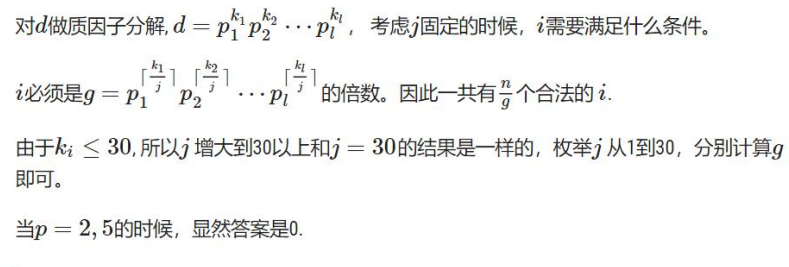Title:
The known sequence A is 1, 11, 111, 1111,... 1, 11, 111, 1111,... 1, 11, 111, 1111,... See
Train of thought:
 Well, then there is the ___________.
Well, then there is the ___________.
Consider In relation to p, first consider the reciprocity of 9 and P
In relation to p, first consider the reciprocity of 9 and P
Then it can be changed into ____________.
Because of reciprocity inv9_0
So only
Namely
According to Fermat's small theorem, 10 and p are mutually prime.


Because  Then the cyclic section is at least p_1. Consider whether there are smaller cyclic sections according to the properties of congruences.
Then the cyclic section is at least p_1. Consider whether there are smaller cyclic sections according to the properties of congruences.

Let d be the factor of p_1, that is, d_p_1, and the smallest cyclic node may be d.

So we can test the factor of p_1 to get the smallest cyclic section D. After finding the smallest cyclic section d, how can we solve the problem? Since the cyclic section is d, It must be a multiple of d. Consider that j is fixed, so long as i contains
It must be a multiple of d. Consider that j is fixed, so long as i contains That's OK. Let's do that.
That's OK. Let's do that. So the number of multiples of g in 1 n is
So the number of multiples of g in 1 n is . Considering g, we can uniquely decompose d.
. Considering g, we can uniquely decompose d.
Then there will be _____________
g has.
With the change of j, the value of g also changes. When the value of j is
When the value of j is When g changes with time, we calculate the contribution of each of them separately as ___________.
When g changes with time, we calculate the contribution of each of them separately as ___________. When J > maxn, g will not change its contribution.
When J > maxn, g will not change its contribution.

So the answer can be counted, but when p=2, p=5, 9 and P are mutually prime, but they are ____________. So the obvious answer is 0. Second, let's consider the case of p=3. Because p=3 is not mutually exclusive in denominator 9, we can't do that as above. Consider
So the obvious answer is 0. Second, let's consider the case of p=3. Because p=3 is not mutually exclusive in denominator 9, we can't do that as above. Consider

Because For length
For length If a continuous integer of 1 is divisible by 3, we know that the sum of the digits on each bit of A(i) is S, which is a multiple of 3.
If a continuous integer of 1 is divisible by 3, we know that the sum of the digits on each bit of A(i) is S, which is a multiple of 3. The sum of each is the sum of each.
The sum of each is the sum of each. j Because every bit on A is 1, so S=i, the final answer is n/3 m.
j Because every bit on A is 1, so S=i, the final answer is n/3 m.
#include <iostream>
#include <cstdio>
#include <cmath>
#include <algorithm>
#include <cstring>
#define ll long long
using namespace std;
ll power(ll a,ll b,ll mod)
{
ll ans=1;
while(b)
{
if(b&1)
ans=(ans*a)%mod;
b>>=1;
a=(a*a)%mod;
}
return ans%mod;
}
ll powerr(ll a,ll b)
{
ll ans=1;
while(b)
{
if(b&1)
ans=ans*a;
b>>=1;
a=a*a;
}
return ans;
}
pair<int,int>a[1005];
int main()
{
int t;
cin>>t;
while(t--)
{
ll p,n,m;
cin>>p>>n>>m;
if(p==2||p==5)
{
cout<<0<<endl;
continue;
}
if(p==3)
{
cout<<n/3*m<<endl;
continue;
}
int minn=p-1;
ll x=minn;
for(int i=2;i*i<=x;i++)//Looking for the cyclic section of D
{
if(x%i==0)
{
if(power(10,i,p)==1)
minn=min(minn,i);
if(power(10,x/i,p)==1)
minn=min(1ll*minn,x/i);
}
}
int cnt=0;
int maxn=0;
x=minn;
for(int i=2;i*i<=x;i++)// Decomposition of D into prime factors
{
if(x%i==0)
{
a[cnt].second=0;
a[cnt].first=i;
while(x%i==0)
{
a[cnt].second++;
x/=i;
}
maxn=max(maxn,a[cnt].second);
cnt++;
}
}
if(x>1)
{
a[cnt].first=0;
a[cnt].second=0;
a[cnt].first=x;
a[cnt].second++;
maxn=max(maxn,a[cnt].second);
cnt++;
}
ll ans=0;
ll g=1;
for(int j=1;j<=min(1ll*maxn,m);j++)// Every time the smallest g a[cnt].first/j is found, it is rounded up.
{
g=1;
for(int i=0;i<cnt;i++)
{
ll flag=a[i].second/j;
if(a[i].second%j)
flag++;
g=g*powerr(a[i].first,flag);
}
ans=ans+n/g;// There are n/g legitimate i in 1~n
}
if(m>maxn)
{
ans=ans+n/g*(m-maxn);// If the value of m is greater than the maximum index, it can be calculated directly.
}
cout<<ans<<endl;
}
return 0;
}Thanks https://blog.csdn.net/ftx456789/article/details/97294635